Comic books tend to feature the fantastic. Though they’re made up of many genres, comics in America tend to get most closely identified with super-heroes. And as cosmic as those adventures can get, creators strive to ground many of the stories in settings that we can recognize as a real world similar to our own. One of the ways that these connections are made is to include real people as part of the cultural background, from athletes to actors to presidents. In some cases, the president plays a role that’s crucial to the plot, whether they’re having a chat with Superman or serving as a metaphor for a more political purpose. Here are a few key moments when the presidents made appearances in comic books.
1. FDR Founds the Justice Society of America

The first super-hero team in comics, the JSA brought together a number of National (later, DC) luminaries, including Hourman, Dr. Fate, the Spectre, and the original versions of Superman, Batman, Hawkman, Green Lantern, The Flash, The Atom, Wonder Woman, and Black Canary. Behind the scenes, it was editor Sheldon Mayer, writer Gardner Fox, and artist Everett E. Hibbard who put them on the page for the first time in the winter of 1940-1941 in All-Star Comics #3. In that issue, the team was already assembled, and there was no explanation of how they’d gotten together. It wouldn’t be until DC Special #29 in 1977 that the team was given an origin.

President Franklin Delano Roosevelt plays a key on-panel role in putting into motion the mission that gathers the heroes. When the JSA reconvenes in the ongoing war-time series, The All-Star Squadron, in 1981, FDR drives the formation of a larger assembly of homefront heroes and regularly appears along with various other real-life members of his administration, such as adviser Harry Hopkins, FBI Director J. Edgar Hoover, and vice presidents Henry Wallace and Harry Truman.
2. The All-Winners Squad Saves Young JFK

Marvel’s 1940s counterpart to the JSA, The All-Winners Squad, made their debut in 1946. They only appeared in two issues, but they set the dynamic of a super-hero team whose members argued with each other. In 1969, Avengers #71 featured the World War II AWS, who went by the name The Invaders. That appearance proved to be popular enough that Invaders got their own series in the ’70s. During a 1977 appearance in What If? #4, which also included Harry Truman, the team saved the life of a 30-year-old Congressional candidate named John F. Kennedy.

3. Richard Nixon: Super-Villain!

During the “Secret Empire” story, Captain America and his allies took on the titular organization. The battle took Cap all the way to the Oval Office of the White House, where he confronted the Empire’s leader, Number One. Though we never see his face, everything about the scene and dialogue tells us that the villain of the piece is really President Richard Nixon. “Nixon” then takes his own life.
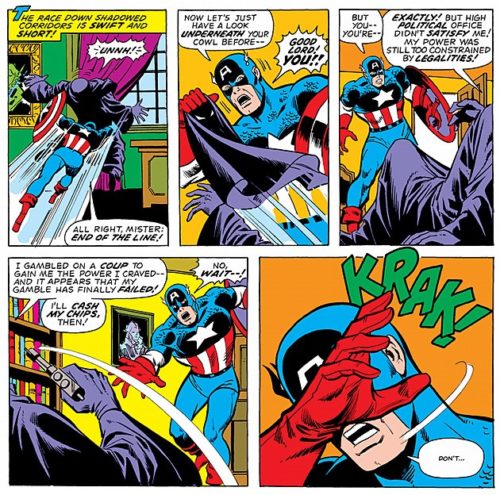
Writer Steve Englehart compared the unfolding Watergate drama of the time to America living its own version of a political thriller. He says, “I decided to do a story that paralleled the real story, with no set idea of where it would end up because we Americans had no set idea of where the real story would end up.”
As Englehart wrote his scripts, the real story continued to play out; however, “Secret Empire” came to a head sooner than Watergate. He says, “By the time I needed to wrap up my story, Nixon had not yet been nailed, but it was obvious he was going to be, so I ended my story with “someone” who inhabited the Oval Office as the ultimate villain. It was my decision not to name that someone because the real Nixon had not yet been nailed.”
Throughout his long and varied career in comics, Englehart has never shied away from controversial stories. It was less by design, and more about approaching reality. Englehart says, “I didn’t set out to do controversial topics, but I found as I learned my craft that I wanted to tell stories (even fantasy stories) that felt real, and “real” led me all sorts of places.”
Englehart wouldn’t be the only writer to use Richard Nixon. Perhaps the other most famous Nixon story is part of Alan Moore and Dave Gibbons’s 1986 epic Watchmen; in that series, Nixon is still president in an alternate 1985 where the United States won the Vietnam War through the super-powered intervention of Dr. Manhattan. Throughout the story, it’s insinuated that Nixon was complicit in the Kennedy assassination and the deaths of Woodward and Bernstein via his operative The Comedian.
4. Ronald Reagan Gets Played Straight and Satirically
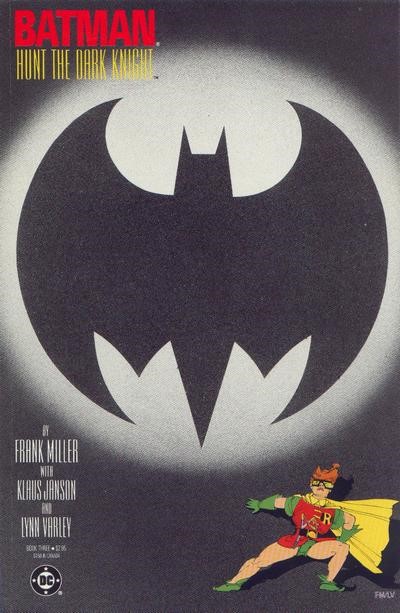
1986 turned out to be a big year for presidents at DC Comics. In addition to Nixon in Watchmen, Ronald Reagan made significant appearances in both The Dark Knight Returns and Legends. In Legends, a crossover series that ran through ’86 and ’87, Reagan appears in several scenes as the country is gripped in an anti-hero hysteria stoked by agents of the villainous Darkseid. Reagan’s biggest scene is a conversation with Superman in which the president tries to justify declaring martial law to protect the public.
A less benevolent version of Reagan appears in the Frank Miller/Klaus Janson/Lynn Varley classic The Dark Knight Returns. In that dystopian vision of a broken world that desperately needs its heroes to return, a much older Reagan (yet still president) appears in news bits and in conversation with, again, Superman. Later, tensions between the U.S. and Russia lead to a nuclear launch, with Reagan taking to the TV in hazmat gear to “reassure” the public.

5. The Clintons Attend the Funeral of a Friend
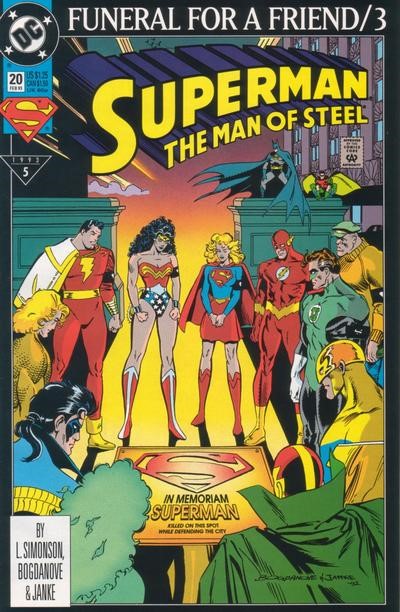
Though Bill and Hillary Clinton would show up a few times in the ’90s, their most notable moment is when they speak at Superman’s funeral. During the three-movement epic, The Death of Superman, Funeral for a Friend, and Reign of the Supermen/The Return of Superman from 1992 and 1993, Superman is killed fighting the monster called Doomsday. A massive funeral for him takes place in Metropolis in Superman: The Man of Steel #20, at which point the Clintons appear to expound on his legacy. By the end of the story, Superman is able to return; we’re certain the Clintons were delighted.
6. Obama Meets Spider-Man (and Ash)

When President Barack Obama was elected in 2008, it was owed in part to his wide-ranging popularity with younger voters. Part of that popularity stemmed from his legitimate fandom of things that also connected with those young voters, including comics. Obama proclaimed on NPR that his favorites growing up were Marvel’s Spider-Man and Conan the Barbarian. Naturally, it was only a matter of time before the House of Ideas would find a way for the new president to meet his favorite wall-crawler. When the president appeared on the cover and in the story for Amazing Spider-Man #583 in January 2009, the response was seismic; within 24 hours, the issue had to be rushed to its third printing. Reporters like myself covered sell-outs and sky-high eBay prices from around the country. Obama, having already been covered in two comics-style biographies at that point, would go on to have multiple appearances in comics, including Savage Dragon (more on Dragon in a minute), Youngblood, the animated Batman: The Brave and The Bold, and more. One of the funniest is in the Army of Darkness spin-off Ash Saves Obama at Dynamite, which features the zombie-fighting Ash rescuing the president from the Evil Dead.
7. Donald Trump vs. Savage Dragon
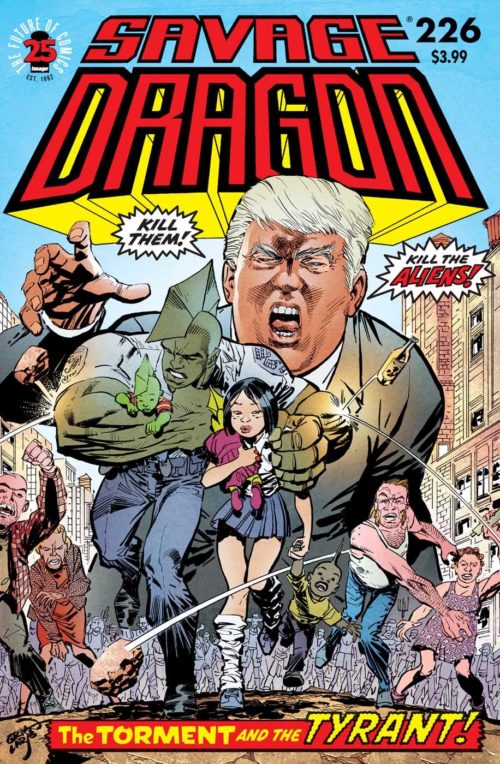
Savage Dragon by Erik Larsen quickly established itself as one of the flagship books of the upstart Image Comics company in 1993. Founded by popular artists who wanted to control their characters and creative destinies, Image has brought the world best-selling and media-adapted comics that include Spawn, Saga, and The Walking Dead. Savage Dragon has been going strong for 26 years, and the book continues to be written and drawn by Larsen.
Savage Dragon, which follows the adventures of a super-strong, green-skinned, head-finned hero, and now his son, tackles topics like racism and religion head on. Larsen has also included every president since George H.W. Bush in the comic in one form or another (as Dragon is one of the few long-term books that acknowledges that passage of “real-world time”). Recently, Donald Trump made his way into the pages and onto a controversial cover with issue #226. Larsen directly addressed issues of immigration in the context of a story about an extraterrestrial ban.

Larsen thought it was important to balance his approach. He says, “I did try to show a variety of opinions in the story, from simple support to vitriolic hatred of aliens and others. Even if you were a staunch supporter [of Trump], you have to acknowledge that some supporters are a bit extreme and even embarrassing.” The writer/artist added more verisimilitude by sourcing quotes for Trump supporters in the story directly from YouTube comments and Facebook groups. He says, “At the same time, I didn’t want to paint everybody with the same brush or even put people in an unfair light, which is why I ended up using so much material verbatim. I picked and chose words carefully, making only minor edits to make their points pertinent to the situation in the book.”
Become a Saturday Evening Post member and enjoy unlimited access. Subscribe now
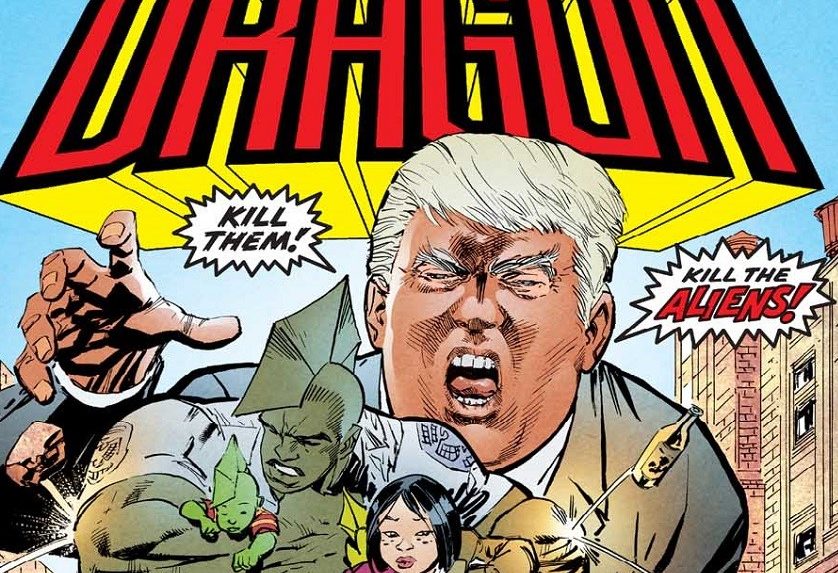


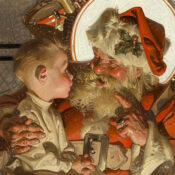
Comments
Just a quick reminder to our commentors. In the first paragraph of the piece, I wrote “Here are a few . . .”
The list did not pretend to be exhaustive. We chose. Reagan in particular appears in dozens of comics across companies in the ’80s. We were looking at individual moments of larger significance, which is why we specifically picked the DKR Reagan appearance.
We appreciate your fandom, but this isn’t a case of forgetting. Thanks for reading!
You forgot Ronald Reagan. Who appears more than once in Marvel. Like in The Incredible Hulk, showing the presidents signature on Hulk’s amnesty papers.
Just to draw attention back to a line in the first paragraph: these are some of the appearances we chose to highlight. The piece did not aim to be a complete checklist. But we are glad that readers have come to share their personal favorites! Thanks!
This article missed the Superman story where JFK helps him by covering for him as Clark Kent.
Oops! I meant “a line that fits both men!”
Regarding presidents popping up in comic books; “World’s Finest Comics” #226 featured a story “The Freak Who Never Fails,” co-starring Batman, Superman and Metamorpho. It’s the latter hero who saves the day and a famous scientist. The ending featured the President in the Oval Office, I’m assuming it was intended to be Nixon; we don’t see his face. Which was fortunate, because the comic hit the stands in mid-August, 1974 around the time Nixon resigned and Ford took over. I’ve wondered if the writers took that possibility into account, because there’s a reference to football being the President’s favorite sport; a lint that fits both men! (Unrelated; I re-read and re-read this issue which also featured reprints featuring Eclipso and the Martian Manhunter’s first two stories. I had just turned 14.) Oh, and a ’70s All Star Squadron story has the team (during WWII) trying to save nine diverse people from a mysterious killer, a killer who had foud out who the next nine U.S. Presidents were going to be—a twist only revealed in the story’s last panel!